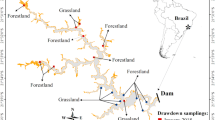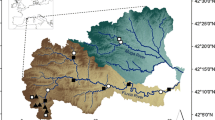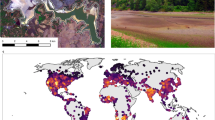Abstract
We assessed the spatial variability in both, surface carbon dioxide (CO2) fluxes and in pelagic respiration rates in a newly created 600-km2 boreal reservoir, located in Northern Quebec. We show that total CO2 emission to the atmosphere was highest in the first year after flooding, and that surface fluxes were spatially heterogeneous. This spatial heterogeneity was not random, but was linked to the pre-flood landscapes: reservoir areas overlying former peatbogs and mature forests had the highest average emissions, whereas areas overlying former non-forest and burned soils had the lowest emissions. Total reservoir emissions appeared to decline exponentially in the next 2 years, and so did the degree of spatial heterogeneity in surface fluxes, suggesting a progressive weakening of the link to the pre-flood landscapes, and a homogenization of reservoir processes. We show that pelagic respiration rates were also initially high and spatially heterogeneous, the latter linked to the pre-flood landscapes. A simple, first-order mass balance for the first 3 years after flooding was used to derive potential benthic CO2 production rates, and thus to apportion the total reservoir emissions between its pelagic and benthic components. Extrapolation of the observed declines (normal exponential) in total emission, as well as of the underlying pelagic and benthic fluxes, results in a large underestimation of the fluxes for the fourth year, relative to the measured emissions. We postulate that the initial exponential decline in total emissions is driven primarily by the patterns of decomposition of surface plant biomass, whereas at later stages emission is increasingly dominated by sediment and pelagic respiration, which decline in time at a slower rate.








Similar content being viewed by others
References
Allan JD, Castillo MM. 2007. Stream ecosystem metabolism. Stream ecology: structure and function of running waters. Dordrecht: Springer. p 436.
Banville JL, Pare D, Garneau M. 2010. Soil carbon stocks and soil carbon quality in a boreal landscape, James Bay, Quebec. Ecosystems (submitted)
Bodaly RA, Beaty KG, Hendzel LH, Majewski AR, Paterson MJ, Rolfhus KR, Penn AE, St. Louis VL, Hall BD, Matthews CID, Cherewyk KA, Mailman M, Hurley JP, Schiff SL, Venkiteswaran JJ. 2004. Experimenting with hydroelectric reservoirs. Environ Sci Technol 38:347A–52A.
Bolin B, Houghton JT, Filho GM, Watson RT, Zinyowera MC, Bruce J, Lee H, Callander B, Moss R, Haites E, Moreno RA, Banuri T, Dadi Z, Gardner B, Goldemberg J, Hourcade J-C, Jefferson M, Melillo J, Mintzer I, Odingo R, Parry M, Perdomo M, Quennet-Thielen C, Vellinga P, Sundararaman N. 1995. IPCC second assessment: climate change. A report of the intergovernmental panel on climate change. IPCC website. http://www.ipcc.ch/pdf/climate-changes-1995/ipcc-2nd-assessment/2nd-assessment-en.pdf. Retrieved 2009-03-08
Bonneville M-C, Strachan IB, Humphreys ER, Roulet NT. 2008. Net ecosystem CO2 exchange in a temperate cattail marsh in relation to biophysical properties. Agric For Meteorol 148:69–81.
Crusius J, Wanninkhof R. 2003. Gas transfer velocities measured at low wind speed over a lake. Limnol Oceanogr 48(3):1010–17.
del Giorgio PA, Peters RH. 1993. Balance between phytoplankton production and plankton respiration in lakes. Can J Fish Aquat Sci 50:282–9.
Duchemin E, Lucotte M, Canuel R. 1999. Comparison of static chamber and thin boundary layer equation methods for measuring greenhouse gas emissions from large water bodies. Environ Sci Technol 33:350–7.
Fearnside PM. 1996. Hydroelectric Dams in Brazilian Amazonia: response to Rosa, Schaeffer and dos Santos. Environ Conserv 23:105–8.
Galy-Lacaux C, Delmas R, Jambert C, Dumestre J-F, Labroue L, Richard S, Gosse P. 1997. Gaseous emissions and oxygen consumption in hydroelectric dams: a case study in French Guyana. Global Biogeochem Cycles 11:471–83.
Galy-Lacaux C, Delmas R, Kouadio J, Richard S, Gosse P. 1999. Long-term greenhouse gas emissions from hydroelectric reservoirs in tropical forest regions. Global Biogeochem Cycles 13:503–17.
Guérin F, Abril G, de Junet A, Bonnet M-P. 2008. Anaerobic decomposition of tropical soils and plant material: Implication for the CO2 and CH4 budget of the Petit Saut Reservoir. Appl Geochem 23:2272–83.
Hesslein RH. 2005. Using gas exchange estimates to determine net production of CO2 in reservoirs and lakes. In: Tremblay A, Varfalvy L, Roehm CL, Garneau M, Eds. Greenhouse gas emissions: fluxes and processes hydroelectric reservoirs and natural environments. Berlin: Springer. p 563–74.
Hoffert MI, Caldeira K, Jain AK, Haites EF, Harveyk LDD, Potter SD, Schlesinger ME, Schneider SH, Watts RG, Wigley TML, Wuebbles DJ. 1998. Energy implications of future stabilization of atmospheric CO2 content. Nature 395:881–4.
Horwath WR. 2007. Carbon cycling and formation of soil organic matter. In: Paul EA, Ed. Soil microbiology, ecology and biochemistry. New York: Academic Press. p 303–39.
Huttunen JT, Vaisanen TS, Heikkinen M, Hellsten S, Nykanen H, Nenonen O, Martikainen PJ. 2002. Fluxes of CH4, CO2, and N2O in hydroelectric reservoirs Lokka and Porttipahta in the northern boreal zone in Finland. Global Biogeochem Cycles 16:711–25.
CC IP. 2006. Intergovernmental panel on climate change (IPCC). Climate change 2006 the scientific basis. Cambridge, UK: Cambridge University Press.
Jonsson A, Algesten G, Bergstrom AK, Bishop K, Sobek S, Tranvik LJ, Jansson M. 2007. Integrating aquatic carbon fluxes in a boreal catchment carbon budget. J Hydrol 334:141–50.
Kalff J, Ed. 2002. Limnology: inland water ecosystems. Upper Saddle River, NJ: Prentice-Hall Inc.
Kelly CA, Rudd JWM, Bodaly RA, Roulet NP, St. Louis VL, Heyes A, Moore TR, Schiff S, Aravena R, Scott KJ, Dyck B, Harris R, Warner BGE. 1997. Increases in fluxes of greenhouse gases and methyl mercury following flooding of an experimental reservoir. Environ Sci Technol 31:1334–44.
Marchand D, Prairie YT, del Giorgio PA. 2009. Linking forest fires to lake metabolism and carbon dioxide emissions in the boreal region of Northern Quebec. Glob Change Biol 15:2861–73.
Matthews CJD, St. Louis VL, Hesslein RH. 2003. Comparison of three techniques used to measured diffusive gas exchange from sheltered aquatic surfaces. Environ Sci Technol 37:772–89.
Oelbermann M, Schiff SL. 2008. Quantifying carbon dioxide and methane emissions and carbon dynamics from flooded boreal forest soil. J Environ Qual 37:2037–47.
Pace ML, Prairie YT. 2005. Respiration in lakes. In: del Giorgio PA, Williams PJLB, Eds. Respiration in aquatic ecosystems. Oxford: Oxford University Press. p 103–21.
Paterson MJ, Findlay D, Beaty K, Findlay W, Schindler EU, Stainton M, McCullough G. 1997. Changes in the planktonic food web of a new experimental reservoir. Can J Fish Aquat Sci 54:1088–102.
Raich JW, Tufekcioglu A. 2000. Vegetation and soil respiration: correlations and controls. Biogeochemistry 48:71–90.
Roehm CL. 2005. Respiration in wetland ecosystems. In: del Giorgio PA, Williams PJLB, Eds. Respiration in aquatic ecosystems. Oxford: Oxford University Press. p 88–102.
Roehm CL, Prairie YT, del Giorgio PA. 2009. The pCO2 dynamics in lakes in the boreal region of northern Québec, Canada. Global Biogeochem Cycles 23:GB3013. doi:10.1029/2008GB003297.
Rosa LP, Schaeffer R. 1994. Greenhouse gas emissions from hydroelectric reservoirs. Ambio 22:164–5.
Rosa LP, Schaeffer R. 1995. Global warming potentials: the case of emissions from dams. Energy Policy 23:149–58.
Rosenberg DM, Berkes F, Bodaly RA, Hecky RE, Kelly CA, Rudd JWM. 1997. Large-scale impacts of hydroelectric development. Environ Rev 5:27–54.
Roulet NT. 2000. Peatlands, carbon storage, greenhouse gases and the Kyoto protocol: prospects and significance for Canada. Wetlands 20:605–15.
Rudd JWM, Harriss R, Kelly CA, Hecky RE. 1993. Are hydroelectric reservoirs significant sources of greenhouse gases? Ambio 22:246–8.
Savage K, Moore TR, Crill PM. 1997. Methane and carbon dioxide exchanges between the atmosphere and northern boreal forest soils. J Geophys Res 102:29279–88.
Schetagne R. 1994. Water quality modifications after impoundment of large northern reservoirs. Archiv fuer Hydrobiologie, Beiheft, Ergebnisse der Limnologie 40:223–9.
Scott KJ, Kelly CA, Rudd JWM. 1999. The importance of floating peat to methane fluxes from flooded peatlands. Biogeochemistry 47:187–202.
Shurpali NJ, Hyvönen NP, Huttunen JT, Biasi C, Nykänen H, Pekkarinen N, Martikainen PJ. 2008. Bare soil and reed canary grass ecosystem respiration in peat extraction sites in Eastern Finland. Tellus 60B:200–9.
Soumis N, Canuel R, Lucotte M. 2008. Evaluation of two current approaches for the measurements of carbon dioxide diffusive flux from lentic ecosystems. Environ Sci Technol 42:2964–9.
St. Louis VL, Kelly CA, Duchemin E, Rudd JWM, Rosenberg DM. 2000. Reservoir surfaces as sources of greenhouse gases to the atmosphere: a global estimate. BioScience 50:766–75.
Starr M, Hartman M. 2003. Tree biomass and soil carbon densities and stocks for a small forested catchment in eastern Finland. In: Honkanen JO, Koponen PS, Eds. Proceedings of Sixth Finnish Conference of Environmental Sciences. Current Perspectives in Environmental Science and Technology. Finnish Society for Environmental Sciences, University of Joensuu, Joensuu. pp. 190–3.
Teodoru CR, delGiorgio PA, Prairie YT YT, Camire M. 2009. pCO2 dynamics in boreal streams of northern Quebec, Canada. Global Biogeochem Cycles 23:GB2012. doi:2010.1029/2008GB003404.
Thérien N, Morrison T. 2005. Production of GHG from the decomposition of in vitro inundated phytomass and soil. In: Tremblay A, Varfalvy L, Roehm CL, Garneau M, Eds. Greenhouse gas emissions: fluxes and processes, hydroelectric reservoirs and natural environments. Berlin: Springer. p 315–38.
Tremblay A, Lambert M, Gagnon L. 2004. Do hydroelectric reservoirs emit greenhouse gases? Environ Manage 33:S509–17.
Tremblay A, Varfalvy L, Roehm CL, Garneau M, Eds. 2005. Greenhouse gas emissions: fluxes and processes, hydroelectric reservoirs and natural environments. Berlin: Springer. p 732.
Vachon D, Prairie YT. 2010. Unifying relationships between wind speed and gas transfer velocity in lakes. Environ Sci Technol (submitted)
Vachon D, Prairie YT, Cole JJ. 2010. The relationship between near-surface turbulence and gas transfer velocity in freshwater systems and its implications for floating chamber measurements of gas exchange. Limnol Oceanogr 55(4):1723--32.
Victor DG. 1998. Strategies for cutting carbon. Nature 395:837–8.
Weissenberger S, Duchemin E, Houel S, Canuel R, Lucotte M. 1999. Greenhouse gas emission and carbon cycle in boreal reservoirs. In: Rosa LP, des Santos MA, Eds. Dams and climate change. Proceedings of the International Conference on Greenhouse Gas Emissions from Dams and Lakes, December 1998, Rio de Janeiro
Acknowledgments
This research was supported, both financially and logistically by Hydro-Quebec, through the Hydro-Quebec/UQAM Eastmain-1 Research project. We especially thank A. Tremblay (Hydro-Quebec) for his continuing support to this project. We would also like to thank M. Camire, A. St. Pierre, D. Marchand, and S. Barette, for field assistance, and C. Beauchemin for laboratory analysis.
Author information
Authors and Affiliations
Corresponding author
Additional information
Author Contributions
All the authors have contributed equally at conceiving and designing this study and to the writing process.
Rights and permissions
About this article
Cite this article
Teodoru, C.R., Prairie, Y.T. & del Giorgio, P.A. Spatial Heterogeneity of Surface CO2 Fluxes in a Newly Created Eastmain-1 Reservoir in Northern Quebec, Canada. Ecosystems 14, 28–46 (2011). https://doi.org/10.1007/s10021-010-9393-7
Received:
Accepted:
Published:
Issue Date:
DOI: https://doi.org/10.1007/s10021-010-9393-7




